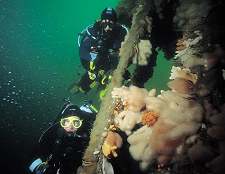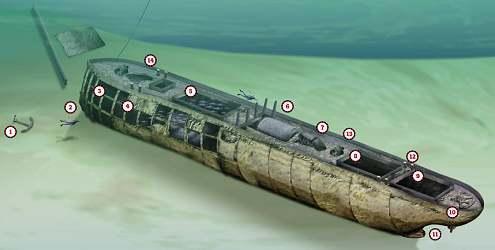You can drift onto the attractive wreckage of this iron steamer, which sank in the Sound of Mull in 1889, at any state of the tide. That’s what JOHN LIDDIARD does. Illustration by MAX ELLIS
AT 500 TONS GROSS, THE THESIS WAS QUITE a small ship, but it is a very pretty wreck and well worth diving. Situated across the current to the west of Rubha an Ridre, the Thesis is quite popular as a second dive on the way back to Oban, after having dived another wreck further up the Sound of Mull on slack water.
Slack water would at first seem essential to dive the Thesis, but local skippers have developed a practice of dropping divers in upcurrent of the wreck so that they can drift onto it at any state of the tide.
Assuming an ebb tide, the current will be flowing down the Sound of Mull towards Oban. Bearing in mind the strength of the current and that some divers can take a while to get to the bottom, the drop-off point could easily be 100m upcurrent to the north-west of the wreck.

As you will want to stop at the wreck, don’t take a surface marker buoy with you for this drift, but carry a delayed SMB you can use to ascend when you leave the wreck, or in case you miss it. Occasionally swim cross-current to stay on the 24m contour.
The first sign of the Thesis will be an anchor lying in the sand (1), quickly followed by the hull of the wreck just back from the bow (2). So long as you are on the 24m contour the wreck is hard to miss, because the visibility is usually excellent and the Thesis rises 4m above the seabed.
With the current flowing round the bow, there are often large shoals of pollack hanging just above the wreck there. Many of the hull-plates have fallen clear of the wreck, leaving a latticework of girders covered with white and yellow dead men’s fingers.
Just below deck level, a couple of broken ribs leave a hole big enough to fit through into the bow section (3). Alternatively, going round the bow to the starboard side brings you to a much larger hole into the same part of the wreck. With hull-plates missing from either side, the current can really whistle through here.
Moving aft, a broken bulkhead provides access to the forward hold (4) with a small hatch open to the deck above. Current will still be flowing through the wreck, but here it is much easier to manage.

Further aft, the main cargo-hatch can provide an easy and safe exit to the deck (5), but I prefer to continue inside on the starboard side of the ship, where there is access alongside the boiler (6) to the engine-room. The wreck here is open above, with the remains of the engine (7) canted to port.
Back below decks, the route along the starboard side continues to the aft holds (8). The hull-plates aft of the boiler on the port side are still in place, but most of the plates on the starboard side are missing. Another broken bulkhead allows easy access between the holds without having to venture above deck.
Coming to the end of the holds (9), you have to pop out above deck and hang on in the current. At the stern, the remains of the steering mechanism are still in place, a cam-shaped pulley attached to the top of the rudder-post (10).
Dipping over the downcurrent starboard side and hitting the seabed at 33m, the propeller and rudder have both been removed (11). Presumably the rudder was cut clear to enable the propeller to be salvaged.
The return route to the bow can either be along the seabed on the sheltered side of the wreck, or along the deck in the current. With a wreck as small as the Thesis, and taking advantage of a dive-computer, there should be plenty of time to explore in more detail.

On the way back, keep an eye out for pairs of bollards between the aft holds (12) and a winch just behind the top of the engine (13). If you originally followed the inside of the wreck to the stern, now is your chance to view the upper parts of the engine, the top of the boiler and the remaining struts from the wheelhouse.
I doubt whether the wreck has been wire-swept. The wheelhouse was most likely wood and has rotted away in the 110 years since the Thesis went down.
Back at the bow, there are a further two pairs of bollards and the anchor-winch (14). I like to save enough time to hang out at the bow for a bit at the end of my dive. Being shallowest with most light and open on both sides, the bow of the Thesis is a great photo-opportunity.
Options for ascent include the buoy-line attached to the bow, drifting on a delayed SMB or swimming upslope to the shore. Bear in mind that the buoy-line could easily drag under in the current once divers are on it, and the shore might not be a safe option for larger boats to recover divers, so a delayed SMB is usually the best choice here.
A similar dive-plan can accommodate the current on the flood tide, dropping into the south-east of the wreck and following the now-sheltered port side back from the stern. At slack water there is always the option of descending the buoy-line.
TAKING A SHORT CUT
They launched the iron steamer Thesis down the slipway of McIlwaine, Lewis in Belfast into a bitter, misty January morning in 1887, writes Kendall McDonald. She behaved well from the moment her keel hit the water.
Certainly Captain Wallace and his 11-man crew had no complaints about her performance during the two years and nine months they were together, carrying all sorts of cargo around Britain and to the Continent.
The 378-ton Thesis was 50m long with a beam of 8m, and drew nearly 6m. In early October, 1889, she left Middlesbrough carrying a cargo of pig-iron for her home port of Belfast. She went north around the tip of Scotland and, to avoid the stormy waters of the Tiree Passage, took the often calmer short cut through the Sound of Mull.
In thick fog, just after midnight on 16 October, 1889 the Thesis ran onto a reef just off the eastern shore of the southern end of the Sound. There was no doubt that she was badly damaged and Captain Wallace ordered everyone into the boats. It was a wise move. It was not long before his ship slid off the reef and sank in deep water.
In more recent days the wreck has been well salvaged by Richard Grieve of the Mull Diving Centre at Salen on the Isle of Mull. The blasting-off of the plates of the hull during that salvage has let in more light and added to the interest of dives on this wreck.
GETTING THERE: Heading into Glasgow from the south, take the M8 west and cross the Erskine Bridge. Then follow the A82 along the side of Loch Lomond and the A85 to Oban. To avoid Loch Lomond and summer traffic jams, a longer but sometimes faster route is to follow the A80 east from Glasgow, then the M80 and M9 past Stirling and the A84 through Callander before joining the A85. For Lochaline, turn right across the Connel Bridge just before Oban. Follow the A828 north past Tralee to take a short ferry-ride across Loch Linhe at Corran, then head south again on the A861 and A884. Ferries crossing to Mull run from Oban to Craignure and Lochaline to Fishnish.
DIVING AND AIR: Lochaline Dive Centre, Alchemy Diving at Tralee, Tralee Dive Centre. In Oban, Puffin Dive Centre, Oban Divers. A number of day-boats operate from Oban and the surrounding area.
ACCOMMODATION: Boat-skippers and dive-centres can provide details of local accommodation. For information on campsites, caravans, B&B and hotels, contact Oban tourist information.
LAUNCHING: The closest slip is at Lochaline. Further afield, there are a number of slips in Oban, and a slip at Tralee where it is also possible to launch across the beach.
TIDES: Slack water is at high- or low-water Oban, but experienced divers often drift onto the Thesis and hide inside.
HOW TO FIND IT: The charted position for the Thesis is 56 30.03N, 5 41.43W (degrees, minutes and decimals), about 50m from the shore on the west of Rubha an Ridre. The wreck is usually marked by a small plastic buoy tied to the bow. If it is not, find 25m with an echo-sounder and follow this contour parallel to the shore. The Thesis will show up, rising 3 or 4m from the seabed.
QUALIFICATIONS: The Thesis is best suited to sport divers and above who have some experience of diving in currents.
FURTHER INFORMATION: Admiralty Chart 2390, Sound Of Mull. Ordnance Survey Map 49, Oban & East Mull. Argyll Shipwrecks by Peter Moir & Ian Crawford. Dive Scotland Vol 2: Dive North-west Scotland, by Gordon Ridley. Shipwrecks Of The West of Scotland by Bob Baird.
PROS: Removed hull-plates allow lots of light inside and make wreck-penetration easy. Sheltered from all but the worst weather. Usually excellent visibility.
CONS: Strong tides.
Appeared in Diver, March 2001


Brilliant dive lots of life deadmens fingers
Festooned steel plates fallen off a lattice work of colour Great vis and shallow
Rondo not far away the two dives great.